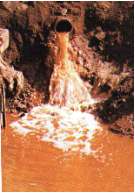| The Hows and Whys of Extinction |
|
Pollution The widespread increase of various pollutants and poisonous or toxic substances in the environment has obvious local impacts on biodiversity in acutely affected areas. Polluting incidents that destroy fish stocks in rivers are fairly commonly reported in the media, this can be repaired by re-stocking and may not have lasting long-term effects. The damage to flora and fauna in the vicinity of a metal smelting plant is also fairly easily observed but more difficult to repair and soils may take 10 years or more to recover.
The widespread increase of various pollutants and poisonous or toxic substances in the environment has obvious local impacts on biodiversity in acutely affected areas. Polluting incidents that destroy fish stocks in rivers are fairly commonly reported in the media, this can be repaired by re-stocking and may not have lasting long-term effects. The damage to flora and fauna in the vicinity of a metal smelting plant is also fairly easily observed but more difficult to repair and soils may take 10 years or more to recover.
|

It is however the long term chronic effects of pollution for which there is greatest concern, pollutants that are difficult to bio-degrade that accumulate in species and have an ability to affect reproduction or cause genetic mutation are quite clearly able to harm and reduce biodiversity. The transport of many pollutants has been surprisingly wide and rapid. Organic compounds of chlorine such as DDT, for example, can literally be found all over the world due to atmospheric transport, even though many of these substances have long been banned in western industrialised countries, and they often remain and accumulate in food chains. |